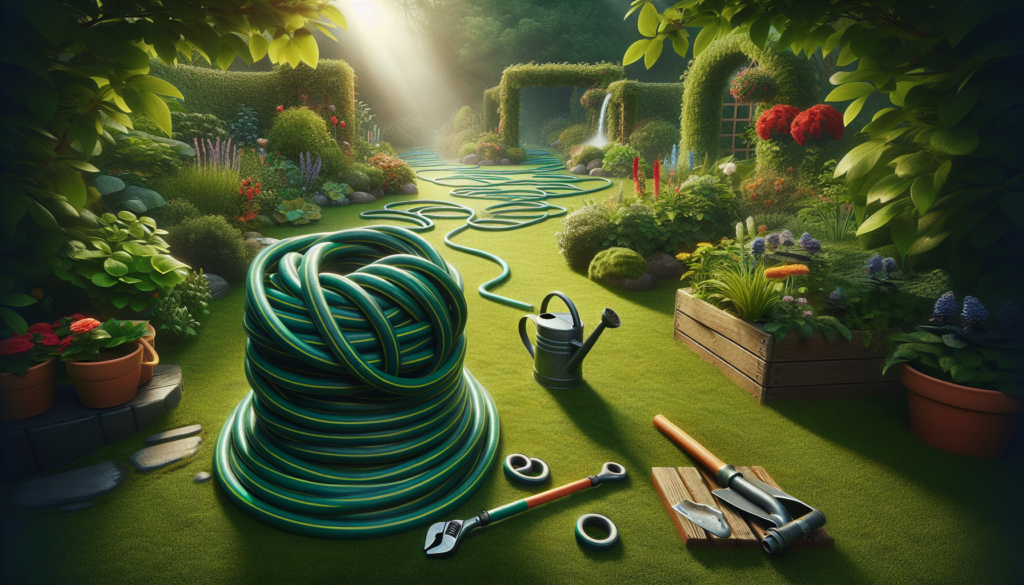Are you tired of wrestling with your garden hose, trying to untangle the frustrating knots and kinks that seem to appear out of nowhere? Well, you’re not alone. Many gardeners have been longing for a kink-free solution to make their watering tasks a breeze. But is there really a hose out there that can deliver on this promise? In this article, we will explore the possibility of finding a kink-free garden hose and discover if there is a solution that can truly revolutionize the way we water our plants.
The Problem with Kinks in Garden Hoses
Nothing is more frustrating than going out to the garden to water your plants, only to find that your hose is tangled and full of kinks. Kinks in garden hoses can disrupt the water flow, reduce the pressure, and even cause damage to the hose itself. Understanding the causes and effects of hose kinks, as well as finding a kink-free solution, is essential for any avid gardener or homeowner.
Causes of Hose Kinks
There are several common causes of hose kinks. One of the main causes is improper storage. If you leave your hose lying on the ground or coiled haphazardly, it can easily develop kinks. Another cause is sharp bends. When you bend the hose too sharply, it can create pressure points that lead to kinks. Lastly, if you accidentally step on the hose or run over it with a lawnmower, kinks can form due to the external force applied.
Effects of Kinks on Water Flow
Kinks in garden hoses can have a significant impact on the water flow. When a hose is kinked, the water struggles to pass through, resulting in reduced pressure and a weakened flow. This can be frustrating when trying to water plants or perform any tasks that require a steady stream of water. Additionally, kinks can lead to irregular water distribution, causing inconsistent watering and potential damage to delicate plants.
Damage Caused by Kinks
Aside from affecting water flow, kinks can also cause damage to the hose itself. When a hose is repeatedly kinked, it puts extra stress on that specific area, leading to wear and tear over time. This can result in leaks, cracks, or even complete hose failure. In addition, kinks can damage the inner lining of the hose, causing it to deteriorate and potentially contaminate the water flowing through it. It’s important to address kinks promptly to prevent further damage and ensure the longevity of your garden hose.
Types of Garden Hoses
When searching for a kink-free garden hose, it’s important to consider the different types available on the market. Each type has its own advantages and considerations to keep in mind.
Vinyl Hoses
Vinyl hoses are a popular choice for their affordability and lightweight design. They are typically made from a combination of PVC and rubber materials. However, vinyl hoses are more prone to kinking, especially in extreme weather conditions. They may not be the best option for those looking for a kink-free solution.
Rubber Hoses
Rubber hoses are known for their durability and resistance to kinks. They have a thicker and more substantial construction compared to vinyl hoses. Rubber hoses can withstand higher water pressures and maintain flexibility even in colder temperatures. However, they can be heavier and more expensive than other options.
Polyurethane Hoses
Polyurethane hoses are a newer addition to the market, offering a balance between durability and flexibility. They are lightweight and resistant to kinking, making them a great option for those seeking a kink-free hose. However, polyurethane hoses tend to be pricier than other types and may not be as widely available.

Features to Look for in Kink-Free Hoses
To find the perfect kink-free hose for your needs, there are several features you should look for during your search.
Flexible Materials
Choosing a hose with flexible materials is crucial in preventing kinks. Look for hoses made from rubber or polyurethane, as these materials offer superior flexibility compared to vinyl. The flexibility allows the hose to maneuver easily around corners and obstacles without forming kinks.
Reinforced Construction
A hose with a reinforced construction is less likely to kink. Reinforcement can come in the form of an additional layer of fabric or mesh within the hose, providing extra strength and stability. Consider hoses with reinforced layers to ensure a kink-free experience.
Anti-Kink Technology
Some manufacturers incorporate anti-kink technology in their hoses to minimize the likelihood of kinks. This can include specially designed outer layers or ridges that help the hose maintain its shape and prevent bending at sharp angles. Prioritize hoses with built-in anti-kink features to save yourself from frustrations down the line.
Top Kink-Free Garden Hoses
After considering the causes, effects, and types of hoses, let’s explore some of the top kink-free garden hoses available on the market.
Brand A Hose
Brand A offers a kink-free garden hose that combines flexibility and durability. Made from rubber with reinforced construction, it provides excellent resistance to kinks. This hose also features anti-kink technology, ensuring a smooth watering experience. Furthermore, Brand A offers a variety of lengths and fittings to suit different gardening needs.
Brand B Hose
Brand B specializes in polyurethane hoses, known for their resistance to kinks. Their kink-free garden hose is lightweight and provides excellent flexibility. With reinforced construction and anti-kink technology, Brand B offers a reliable option for hassle-free watering. They also offer different colors and styles, allowing you to personalize your garden hose.
Brand C Hose
Brand C prides itself on creating kink-free garden hoses suitable for both residential and commercial use. Their hoses are made from a blend of rubber and high-quality materials, ensuring durability and flexibility. The hoses also feature a unique anti-kink mechanism that prevents twisting and bending. Brand C offers a diverse range of hose lengths and fittings to accommodate various outdoor settings.

Comparing Kink-Free Hoses
When considering which kink-free garden hose to purchase, there are several factors to compare, including price, durability, and warranty.
Price
The price of kink-free hoses can vary significantly depending on the brand, material, and length. Consider your budget and compare the prices of different options. Remember to balance affordability with quality to ensure you get the best value for your money.
Durability
Durability is crucial when investing in a kink-free garden hose. Look for hoses with strong construction and materials that can withstand frequent use, extreme weather conditions, and potential rough handling. Reading customer reviews and product descriptions can give insights into durability.
Warranty
A warranty is an important consideration for any product purchase. It provides peace of mind and protects you in case of defects or damages. Compare the warranties offered by different manufacturers and opt for hoses with longer warranty periods to ensure long-lasting performance.
Tips for Preventing Hose Kinks
While choosing a kink-free hose is essential, there are also preventative measures you can take to minimize kinks in any hose.
Proper Hose Storage
Properly storing your hose can prevent kinks from forming. When not in use, make sure to completely drain the water from the hose and avoid leaving it in direct sunlight. Coiling the hose neatly and using a hose reel or hanger can help maintain its shape and prevent tangling.
Avoiding Sharp Bends
Avoid bending the hose at sharp angles, as this increases the likelihood of kinks. When maneuvering the hose around corners or obstacles, do so gradually and smoothly. Taking care to avoid sudden twists or excessive bending can go a long way in preventing kinks.
Using Hose Guides
Hose guides are a useful tool for preventing kinks. They are typically installed along the path where the hose needs to follow. These guides help guide the hose around corners and obstructions, preventing accidental kinks. Using hose guides can make a significant difference in the longevity of your hose.
How to Fix a Kinked Hose
Inevitably, there may be times when your hose still ends up with a kink. Luckily, there are steps you can take to fix it and restore water flow.
Identify the Kink
First, identify the location of the kink in the hose. Inspect the entire length of the hose and look for any visible bends or twists. Identifying the kink will guide you in the next steps to remove it.
Straightening the Hose
Once you’ve located the kink, gently straighten the hose by hand. Slowly apply pressure to the bent area, working your way along the hose until the kink is relieved. Avoid using excessive force, as this can lead to further damage.
Using Heat to Remove Kinks
In some cases, using heat can help remove stubborn kinks. Fill a bucket with hot water and submerge the kinked section of the hose for a few minutes. The heat will soften the hose material, making it easier to straighten out the kink. Remember to wear gloves and exercise caution when working with hot water.
Maintaining Kink-Free Hoses
To ensure the longevity of your kink-free hose and prevent future kinks, regular maintenance is essential.
Cleaning and Washing
Cleaning your hose regularly removes dirt and debris that can contribute to kinking over time. Use a mild detergent and a soft brush to scrub the exterior of the hose. Rinse it thoroughly, paying attention to any potential areas where debris can accumulate. Proper cleaning will not only keep your hose looking good but also prevent kinks caused by build-up.
Inspecting for Wear and Tear
Periodically inspect your hose for signs of wear and tear. Check for any cracks, leaks, or weakened areas. If you notice any damage, address it promptly to prevent further deterioration. Early detection and repairs can help extend the life of your kink-free hose.
Replacing O-Rings and Washers
O-rings and washers play a vital role in preventing leaks and maintaining the integrity of your hose fittings. Over time, they can wear out and become damaged. Regularly inspect these components and replace them as needed. Ensuring a proper seal will help avoid leaks and potential kinks in the hose connections.
Conclusion
A kink-free garden hose is not an elusive myth but a possibility with the right information and consideration. By understanding the causes and effects of hose kinks, as well as the different types and features of kink-free hoses, you can make an informed choice for your gardening needs. Remember to compare prices, durability, and warranty when selecting a hose. Additionally, implementing preventative measures such as proper storage and using hose guides can help minimize kinks. Finally, if a kink does occur, follow the steps to fix it promptly. With regular maintenance, including cleaning and inspecting for wear and tear, your kink-free hose will serve you reliably for years to come. Happy gardening!
